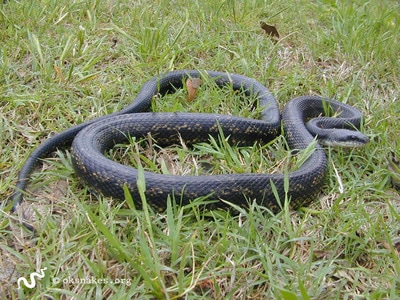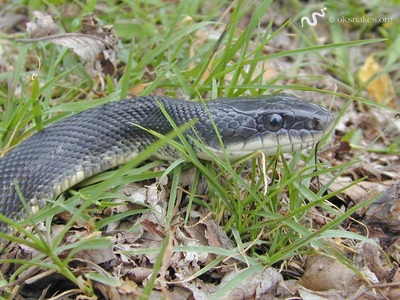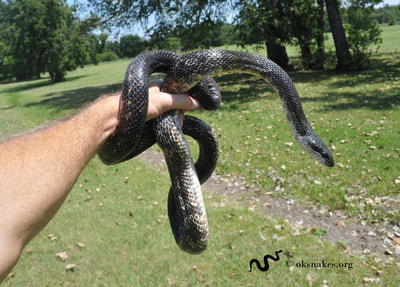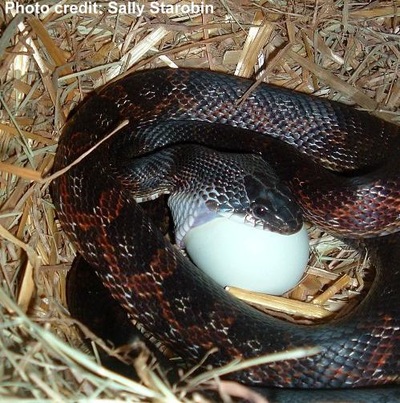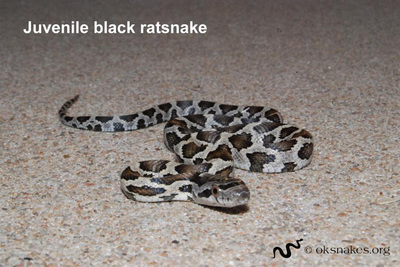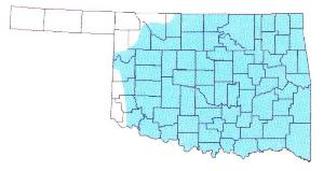Western ratsnake
Pantherophis obsoletus
Pantherophis obsoletus
HARMLESS
Description:
Long, dark-colored constrictor that can vary in coloration. It can be totally black, have dark blotches under a light black color, or be black with some reddish-orange flecks mixed in. The belly is creamy white to greenish-yellow and is sometimes mottled. The scales are weakly keeled and the anal plate is divided.
Size:
Adults 34 - 72 inches (86 - 183 cm)
Prey:
Rodents and other small mammals, birds (and eggs), and small lizards
Reproduction:
Usually mates in early spring and lays 6 - 20 eggs in moist leaf litter or rotting logs. Eggs hatch in late summer and hatchlings are approximately 12" (31 cm) long.
Habitat:
Wooded forests and canyons, open fields, and farmlands
Other Information:
Hatchlings are a light gray with dark blotches and look nothing like the adult form. They have a dark bar that runs across their snout and between their eyes, and they are quick to vibrate their tail when threatened. Many people confuse juvenile ratsnakes with rattlesnakes because of this behavior. (Note: Tail buzzing is not limited to juveniles, as adults are also prone to using this as a defense mechanism)
Adults are commonly found in trees and along the eaves of houses due to their preference for birds and their eggs. This occasionally causes them to get inside of attics, much to the dismay of most homeowners. Other common names for this snake are "black snake," "pilot black snake (for the belief that they lead timber rattlesnakes to their winter den sites)," and "chicken snake."
Many Oklahomans might refer to this as the black ratsnake but recent biological studies have changed the common name and the subspecies was elevated to full species status.
Why doesn't the range map show this species in my county?
Description:
Long, dark-colored constrictor that can vary in coloration. It can be totally black, have dark blotches under a light black color, or be black with some reddish-orange flecks mixed in. The belly is creamy white to greenish-yellow and is sometimes mottled. The scales are weakly keeled and the anal plate is divided.
Size:
Adults 34 - 72 inches (86 - 183 cm)
Prey:
Rodents and other small mammals, birds (and eggs), and small lizards
Reproduction:
Usually mates in early spring and lays 6 - 20 eggs in moist leaf litter or rotting logs. Eggs hatch in late summer and hatchlings are approximately 12" (31 cm) long.
Habitat:
Wooded forests and canyons, open fields, and farmlands
Other Information:
Hatchlings are a light gray with dark blotches and look nothing like the adult form. They have a dark bar that runs across their snout and between their eyes, and they are quick to vibrate their tail when threatened. Many people confuse juvenile ratsnakes with rattlesnakes because of this behavior. (Note: Tail buzzing is not limited to juveniles, as adults are also prone to using this as a defense mechanism)
Adults are commonly found in trees and along the eaves of houses due to their preference for birds and their eggs. This occasionally causes them to get inside of attics, much to the dismay of most homeowners. Other common names for this snake are "black snake," "pilot black snake (for the belief that they lead timber rattlesnakes to their winter den sites)," and "chicken snake."
Many Oklahomans might refer to this as the black ratsnake but recent biological studies have changed the common name and the subspecies was elevated to full species status.
Why doesn't the range map show this species in my county?
